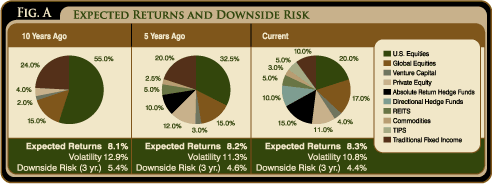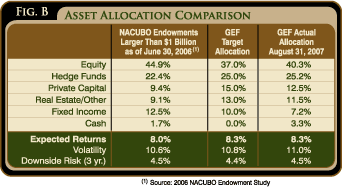|
Investment Strategy, Asset Allocation and Performance
4. What is the investment strategy?
The GEF�s strategy is to invest in a broadly diversified portfolio of equity, fixed income and real assets across global markets using a long-term investment horizon. In order to earn above market returns, UTIMCO has also sharpened its focus on several asset categories characterized by complex, illiquid, and mispriced securities where proprietary information and sophisticated investment strategies offer the opportunity for value-added returns. These asset categories have an additional important advantage. Because these assets typically provide returns which have a low correlation with those of the more traditional exchange-traded equities and fixed income securities in the GEF portfolio, they offer the additional advantage of reducing the overall risk level. These asset categories are generally referred to as high potential value-added assets and include private market investments, marketable alternative investments, and various other specialized investments such as real estate and natural resources.
5. What is the current asset allocation of the GEF and how has the asset allocation changed over the past ten and five years?
To properly diversify the GEF assets, UTIMCO invests in a broad variety of asset categories. This allocation policy was developed through a careful asset allocation review with the UTIMCO Board in which potential returns for each asset category were balanced against the contribution to total portfolio risk by each category. While the allocations in Figure A indicate the longer term average strategic weights of each asset category, UTIMCO repositions the allocations to each asset category from time to time in response to changes in the investment outlook. The asset allocation policy has changed substantially over the past ten year period and five year period compared to the current asset allocation policy as reflected in Figure A.

Click to print charts in this section using PDF format
Figure A also reflects the expected returns and downside risk associated with the asset allocations for each respective time period. Those expected returns and downside risk numbers confirm the importance of maintaining a properly diversified investment portfolio in order to maximize expected return with lower levels of investment risk.
6. How does the current asset allocation compare to other colleges and universities?
Figure B indicates how the current strategic allocation of the GEF compares with other endowment funds larger than $1 billion as reported by the National Association of College and University Business Officers (NACUBO), an endowment industry trade group. The expected returns and expected risk in Figure B are based on UTIMCO�s long term capital market forecasts.

Click to print charts in this section using PDF format
7. What are the significant risks associated with the GEF and how is this risk monitored?
Equity values in the GEF can fluctuate in response to the activities of individual companies as well as to general market conditions. In the short-term, stock prices can fluctuate dramatically in response to these factors. Bond prices in the GEF can also fluctuate based on changes in interest rates and the credit quality of the issuers. Investments in international securities in the GEF can involve political and macroeconomic risk in addition to typical individual company risks as in domestic markets. An additional element of risk in all international investments is the currency risk as the returns on those investments must be converted to U.S. dollars for use here. Some of the longer term investments in the GEF, including venture capital and private equity, also have an element of liquidity risk due to the fact that these investments can not be easily converted to cash at short notice. All these risks are carefully monitored by both the UTIMCO staff and the UTIMCO Board. It is essential that some risk must be assumed in order to earn the levels of real returns necessary to meet the long term goals of the GEF. However, it is particularly important to carefully weigh each element of risk against the reward � expected future returns. The process used at UTIMCO to evaluate risks and rewards is known as risk budgeting and is almost exactly analogous to the normal budgeting process in a business. The UTIMCO staff is charged with carefully budgeting risks so that the risk assumed in the aggregate does not exceed the risk limits set by the UTIMCO Board and the UT Board of Regents. A risk budget also ensures that the rewards � expected future returns � are the best available at a given level of aggregate risk. Risks are monitored daily by UTIMCO staff and monthly by the UTIMCO Board.
8. What does total return mean?
Total return measures how well an investment or group of investments, such as the LTF, have performed over a certain time period. Total return is the sum of: the change in the value (including both realized and unrealized gains and losses) plus income (from dividends or interest for example) measured over a specified period of time. Total return is usually expressed as a percentage calculated by dividing the sum defined in the prior sentence by the beginning value of an investment. Total return is also sometimes referred to as investment return or performance return. If total return is after deduction of investment management fees and expenses, it may also be referred to as total net return.
9. What was the total net return of the LTF over the last year? Over the last five and ten years? How does it compare to the Endowment Policy Portfolio total return?
The table in Figure C summarizes the total net return comparison for the one, five and ten year periods ended August 31, 2007.

Click to print charts in this section using PDF format
|